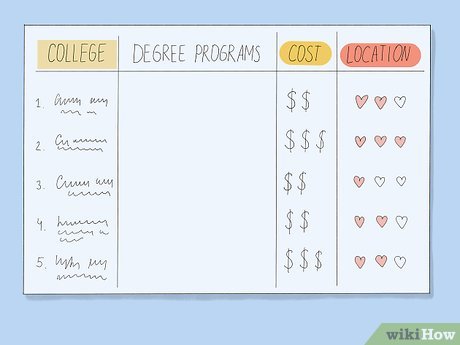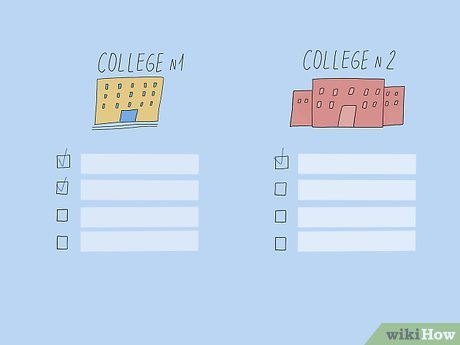How to Apply to College
Deciding Where to Apply
-
 Map out the application process with a timeline. At the end of junior year or over the summer, make a list of all the steps you'll need to take during the application process. Maintaining a bird's-eye-view over these tasks can prevent you from getting overwhelmed help you avoid missed deadlines.[1]
Map out the application process with a timeline. At the end of junior year or over the summer, make a list of all the steps you'll need to take during the application process. Maintaining a bird's-eye-view over these tasks can prevent you from getting overwhelmed help you avoid missed deadlines.[1]- For an example timeline, check out https://bigfuture.collegeboard.org/get-in/applying-101/timeline-12-grade.
Sample Timeline:
1. Narrow list of colleges to between 5 and 10. Deadline: October 15.
2. Ask 2 to 3 teachers for letters of recommendation. Deadline: October 31.
3. Write first drafts of application essays. Deadline: October 31.
4. Arrange for transcripts to be sent to colleges. Deadline: January 15.
5. Complete the Common App and school-specific forms. Deadline: January 15. -
 Discuss potential matches with your guidance counselor. Ask your guidance counselor which colleges and universities match up with your academic performance and interests. They can offer an experienced perspective on which schools you should easily get into and which are more of a reach. If you'd like to pursue a particular field, they can also inform you about schools that offer strong degree programs in your chosen discipline.[2]
Discuss potential matches with your guidance counselor. Ask your guidance counselor which colleges and universities match up with your academic performance and interests. They can offer an experienced perspective on which schools you should easily get into and which are more of a reach. If you'd like to pursue a particular field, they can also inform you about schools that offer strong degree programs in your chosen discipline.[2]- Your guidance counselor is your point person throughout the application process. They help you narrow your list of prospective school, review your application materials, and ensure transcripts and other official documents are sent with your applications.
- It's best to give yourself plenty of time to put your applications together. Start narrowing your list of colleges junior year (or the third year of secondary school) and complete your applications during the first half of your last year in high school.[3]
-
 Reach out to a teacher or mentor if you don't have a guidance counselor. If your school doesn't have a counselor, or if your counselor is overbooked, ask a trusted teacher for help. You could also talk to other mentor figures, such as a coach, club adviser, or a relative who has experience with the application process.[4]
Reach out to a teacher or mentor if you don't have a guidance counselor. If your school doesn't have a counselor, or if your counselor is overbooked, ask a trusted teacher for help. You could also talk to other mentor figures, such as a coach, club adviser, or a relative who has experience with the application process.[4]- Try not to worry if your counselor is unavailable or if your school doesn't have one. There's plenty of great information available online, and a trusted teacher or other mentor can help you navigate the process.
- If you're an adult returning to school and don't have access to a school counselor, reach out to potential colleges for guidance. Ask about the application process for non-traditional students. Instead of sending high school transcripts, you may be able to take a placement exam or receive course credit for prior work or military experience.[5]
-
 Research schools' admissions standards and requirements. Take advantage of admissions websites and college review sites, where you can learn all about potential schools. Look for colleges and universities that have features that appeal to you, such as degree programs, cost, class size, and location.[6]
Research schools' admissions standards and requirements. Take advantage of admissions websites and college review sites, where you can learn all about potential schools. Look for colleges and universities that have features that appeal to you, such as degree programs, cost, class size, and location.[6]- Many college review sites compile lists of colleges that you can browse. They break down how hard it is to get into a school, what kind of SAT or ACT score you need, tuition cost, what campus life is like, and how many alumni get jobs after graduating.
- You can find plenty of information on schools' websites, but you could also ask colleges and universities to send you information packets. Check out admissions websites and look for 'request information' links.
-
 Visit colleges to get a sense of what campus life is like. Researching schools online is one thing, but experiencing campus life firsthand is invaluable. If possible, schedule tours with prospective schools. You may also be able to stay overnight with a first-year student and get a feel for what it's like to live in a dorm. If you have a friend who attends a college you're interested in, ask them to show you around the campus.[7]
Visit colleges to get a sense of what campus life is like. Researching schools online is one thing, but experiencing campus life firsthand is invaluable. If possible, schedule tours with prospective schools. You may also be able to stay overnight with a first-year student and get a feel for what it's like to live in a dorm. If you have a friend who attends a college you're interested in, ask them to show you around the campus.[7]- As you tour potential schools, ask yourself what type of school and surrounding location would be most comfortable. Try to imagine what it would be like to be a student at each school you visit, and ask yourself, 'Can I imagine myself being happy and successful here?'
- If, for instance, you want to experience urban life, look for schools located in bustling cities. Look for colleges off the beaten path if you want a less hectic environment.
- Some universities are enormous, with 30,000 students or more. If smaller class size is important to you, look for liberal arts colleges, which may have just a few hundred students enrolled.
-
 Look for nearby or online universities if you want to stay local. Look into nearby colleges and universities if you have a job you don't want to leave or just want to stay close to home. An online degree program could also be a great option, especially if you're returning to school.[8]
Look for nearby or online universities if you want to stay local. Look into nearby colleges and universities if you have a job you don't want to leave or just want to stay close to home. An online degree program could also be a great option, especially if you're returning to school.[8]- In the United States, lower tuition cost is one major perk of in-state public colleges and universities.
- Talk to your family about the pros and cons of moving away versus staying local. Discuss costs, responsibilities that require you to stay close to home, and other logistics.
-
 Narrow your list to 5 to 10 safety, good match, and reach schools. Choose 1 to 2 safety schools, which you and your guidance counselor are sure you'll get into, and 2 to 4 good matches where you think you'll have a strong chance of being admitted. Additionally, select 1 to 2 reaches, or colleges where getting in isn't a sure thing, but it's realistic enough to be worth applying.[9]
Narrow your list to 5 to 10 safety, good match, and reach schools. Choose 1 to 2 safety schools, which you and your guidance counselor are sure you'll get into, and 2 to 4 good matches where you think you'll have a strong chance of being admitted. Additionally, select 1 to 2 reaches, or colleges where getting in isn't a sure thing, but it's realistic enough to be worth applying.[9]- Try to come up with a list of colleges for each category by autumn of your last year in high school at the latest.
- Keep in mind each school has an application fee, so don't apply to a college just for the sake of it. If paying application fees is an issue, ask your guidance counselor to help you request fee waivers from potential colleges.[10]
Assembling Required Documents
-
 Create a to-do list to stay organized. Early in your senior year, write down all of the application requirements for each of your potential schools. Create a master checklist with the requirements and deadlines for each college. In addition, keep all the documents you compile for each application in individual digital folders on your computer.[11]
Create a to-do list to stay organized. Early in your senior year, write down all of the application requirements for each of your potential schools. Create a master checklist with the requirements and deadlines for each college. In addition, keep all the documents you compile for each application in individual digital folders on your computer.[11]- Most likely, requirements will overlap, but there may be minor differences. One school, for instance, may require 3 letters of recommendation while the others specify 2.
- Colleges usually prefer online applications. However, if you'd rather submit paper applications, or if a school happens to request hard copies of documents, keep them organized in paper folders.
-
 Send your high school transcripts to potential schools. Colleges and universities require official transcripts, which usually need to be sent by an administrator at your high school. Policies vary, but guidance counselors often arrange for transcripts to be sent to potential colleges. Check schools' admissions websites for specifics on the submission process.[12]
Send your high school transcripts to potential schools. Colleges and universities require official transcripts, which usually need to be sent by an administrator at your high school. Policies vary, but guidance counselors often arrange for transcripts to be sent to potential colleges. Check schools' admissions websites for specifics on the submission process.[12]- You may need to download a transcript request form from a school's website and give it to your guidance counselor. Alternatively, your guidance counselor or school administrator may only need to mail or upload your transcript.
- Your transcripts will only show your grades up to the last full term you completed. However, your high school will send a final transcript to your college of choice, so keeping your grades up is still important. Don't slack off the rest of your senior year![13]
- If you're returning to school as an adult, ask schools' admissions programs to help guide you through the application process. In lieu of transcripts, you may be able to take a standardized test or ask schools to take your work experience into consideration.
-
 Write application essays on a unique experience, trait, or achievement. Writing a college application essay may seem daunting, but try to see it as a fun opportunity to express yourself. Review the requirements for each school; your essay may be open ended, or you may be asked to respond to a specific prompt. You'll probably be limited to 1 page or less, so focus on a specific topic that helps you stand out from the crowd.[14]
Write application essays on a unique experience, trait, or achievement. Writing a college application essay may seem daunting, but try to see it as a fun opportunity to express yourself. Review the requirements for each school; your essay may be open ended, or you may be asked to respond to a specific prompt. You'll probably be limited to 1 page or less, so focus on a specific topic that helps you stand out from the crowd.[14]- For instance, you could write about an obstacle you overcame or a trip that changed your view of the world. Just keep in mind the most important thing to be authentic and offer insight into who you are as a person.
- Keep in mind you may need to write multiple essays in response to each application's prompt.
Tip: Have your guidance counselor, at least 1 English teacher, and family members read your essays. Ask them for feedback on the content and to proofread for errors. It's crucial that your writing is free of spelling and grammatical errors.
-
 Ask 2 to 3 teachers to write letters of recommendation. Choose references who know you well and can clearly communicate your talents. Teachers are usually the best bet, but a reference could also be another mentor, such as your boss. Some schools also ask that your guidance counselor submit a letter of recommendation.[15]
Ask 2 to 3 teachers to write letters of recommendation. Choose references who know you well and can clearly communicate your talents. Teachers are usually the best bet, but a reference could also be another mentor, such as your boss. Some schools also ask that your guidance counselor submit a letter of recommendation.[15]- Give your references plenty of notice; at least 2 months is ideal. Be sure to check college admissions websites for specific requirements. If necessary, download and print recommendation forms and give them to your references.
- It's also a good idea to give your references a list of your credentials and activities, just to make sure they have a big picture view of you outside of the classroom.
-
 Send your standardized test scores to prospective colleges. If possible, take the SAT, ACT, or standardized test for your nation more than once. Specific steps to submitting score reports to schools vary by test. In general, you'll just need to enter your potential colleges' ID codes on the test administrator's website.[16]
Send your standardized test scores to prospective colleges. If possible, take the SAT, ACT, or standardized test for your nation more than once. Specific steps to submitting score reports to schools vary by test. In general, you'll just need to enter your potential colleges' ID codes on the test administrator's website.[16]- In the United States, many schools no longer require standardized test scores. A few won't even consider SAT or ACT scores at all. However, there are plenty of colleges and universities that still place heavy emphasis on standardized tests, so don't skip the SAT or ACT.
- Additionally, depending on the school and degree program, you may need to submit subject test scores. For instance, a pre-med program may require SAT subject test scores in science.
-
 Develop a portfolio if you're applying for a creative degree. You'll probably need to submit a portfolio if you're applying to art school or degree programs like fashion design, architecture, or theater. Review potential college's portfolio requirements, and work with your art or design teachers to showcase your best work.[17]
Develop a portfolio if you're applying for a creative degree. You'll probably need to submit a portfolio if you're applying to art school or degree programs like fashion design, architecture, or theater. Review potential college's portfolio requirements, and work with your art or design teachers to showcase your best work.[17]- Your portfolio needs to be as professional as possible. Be sure to include high-resolution images of your work, as well as concise descriptions to set the context for each project.
- Look for submission instructions on the website of your potential school or degree program. You'll either submit a hard copy of your portfolio, upload a digital file through the website, or send a CD or thumb drive.
Submitting Your Application
-
 Fill out application forms according to each college's requirements. While some schools have their own application forms and online portals, many participate in common application programs. For each application, enter your name, contact and personal information, activities, and other required details into the appropriate fields.[18]
Fill out application forms according to each college's requirements. While some schools have their own application forms and online portals, many participate in common application programs. For each application, enter your name, contact and personal information, activities, and other required details into the appropriate fields.[18]- In the U.S., over 800 schools participate in the Common App program. For schools that accept the Common App, you just need to fill out 1 application form, and you and your guidance can upload your essay, transcript, and letters of recommendation directly onto the website at https://www.commonapp.org.[19]
- Outside of the U.S., many nations have 1 universal application that covers all universities. For instance, in the United Kingdom, you'd submit a UCAS application at https://www.ucas.com.[20]
-
 Include your required documents with your application. If you're using the Common App, you can simply upload your required documents through the program's website. For schools that don't take the Common App, you'll most likely need to create an account on their website and upload your documents through their application server.[21]
Include your required documents with your application. If you're using the Common App, you can simply upload your required documents through the program's website. For schools that don't take the Common App, you'll most likely need to create an account on their website and upload your documents through their application server.[21]- Recall that most schools now prefer online submissions. If you prefer to send hard copies and your potential schools accept paper applications, check their admissions websites for mailing addresses.
When to Apply: Generally, deadlines are in January or February, but it's best to submit your application as soon as possible. If you're committed to attending a particular school, you could also apply for early decision. Just remember early decision is binding, and you'll need to enroll in that school if you're accepted and receive enough financial aid.[22]
-
 Pay each school's application fee. If you're using the Common App (or another universal application service), log into the website, head to the 'Review and Submit' section, and search for a potential school. When you submit your application to that school, you'll be prompted to pay an application fee, which is typically between $30 and $90 (U.S.).[23]
Pay each school's application fee. If you're using the Common App (or another universal application service), log into the website, head to the 'Review and Submit' section, and search for a potential school. When you submit your application to that school, you'll be prompted to pay an application fee, which is typically between $30 and $90 (U.S.).[23]- The payment process is similar if you're applying to schools that don't take the Common App.
- The Common App only takes credit or bank cards. Schools that don't accept the Common App may accept checks or bank transfers in addition to cards, so double check admissions websites for acceptable payment forms.
- If application fees are outside of your budget, you can apply for fee waivers through schools' financial aid departments. Ask a parent for help submitting financial information with the waiver applications.
-
 Confirm that colleges have received your materials after a month. For both the Common App and schools with independent application portals, you should be able to log into the website and check your application's status. Otherwise, stay on the safe side and call or email the admissions department to ensure they received all of your required documents.[24]
Confirm that colleges have received your materials after a month. For both the Common App and schools with independent application portals, you should be able to log into the website and check your application's status. Otherwise, stay on the safe side and call or email the admissions department to ensure they received all of your required documents.[24]- Waiting is tough, but try to be patient! It usually takes about 2 or 3 months for a college to notify applicants whether or not they were accepted.
-
 Start the financial aid application process after applying to schools. If you live in the U.S., file your Free Application for Federal Student Aid (FAFSA) as soon as possible after January 1 of your senior year. Your FAFSA determines how much federal financial aid you qualify for; schools that accept you will also let you know if they can offer scholarships, grants, or loans.[25]
Start the financial aid application process after applying to schools. If you live in the U.S., file your Free Application for Federal Student Aid (FAFSA) as soon as possible after January 1 of your senior year. Your FAFSA determines how much federal financial aid you qualify for; schools that accept you will also let you know if they can offer scholarships, grants, or loans.[25]- Once you know how you'll finance your education, you can send a letter of acceptance to your chosen school and take the first steps toward your degree!
You should read it
- How to Understand the Benefits of All Girls Schools
- 3 most used basketball cylinders in school
- The app helps you choose a career, choose a school and know the salary
- Chinese schools are using 'smart uniforms' to monitor students' activities at school
- How to Become a Paraprofessional
- How to improve information security for schools


















 How to Get a PhD
How to Get a PhD How to Enroll at a Community College
How to Enroll at a Community College How to Be a Culturally Competent Science Educator
How to Be a Culturally Competent Science Educator How to Promote Your Academic Career
How to Promote Your Academic Career How to Become a High School Counselor
How to Become a High School Counselor How to Become a Gender Studies Professor
How to Become a Gender Studies Professor